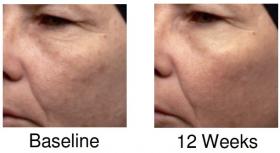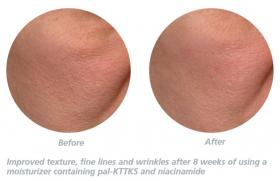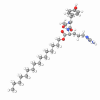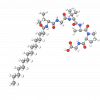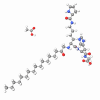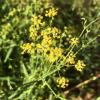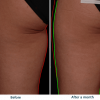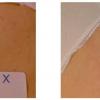Naturally occurring peptides in the skin perform critical roles in skin maintenance and repair, and there is growing interest in harnessing these effects for therapeutic and cosmetic use. Pentapeptide-4 (former pentapeptide-3) is a 5 amino acid length fragment of pro-collagen I (lysine-threonine-threonine-lysine-serine; KTTKS; Micro-Collagen™) protein that stimulates dermal matrix components production by skin fibroblasts. However, delivering KTTKS across the skin was challenging, given its ionic nature.
Matrixyl™ (Palmitoyl pentapeptide-4; former Palmitoyl pentapeptide-3) is the palmitoyl derivative of this pentapeptide (pal-KTTKS) and is more stable and active for topical application thanks to lipophilic conjugate from palmitic acid resulted from research aimed at enhancing peptide delivery while maintaining bioactivity, mildness, and skin benefit potency.
Other data show that pal-KTTKS stimulates collagen synthesis and other dermal matrix components, suggesting possible mechanisms for its skin benefits. In vitro and acute in vivo testing indicates that pal-KTTKS also inhibits excess production of dermal glycosaminoglycans (GAGs) associated with aging skin and induces epidermal thickening, effects which also likely contribute to its clinical benefits.
Multiple chronic human tests with topical application pal-KTTKS lipo-peptide demonstrate improvement in the appearance of facial skin wrinkles without the irritation associated with technology such as retinol, confirming other reported small base testing of this ingredient. Reduction of the appearance of human facial skin wrinkles determined by expert graders, image analysis, and subject self-assessment. The improvement in wrinkle appearance is achieved without the increased skin redness or barrier damage associated with other antiaging actives. In self-assessments, subjects also reported there was a significant improvement in their facial wrinkles, and they also reported small but significant improvements in age spots, dark circles, and skin firmness.Other data show that Matrixyl™ stimulates collagen synthesis and other dermal matrix components, suggesting possible mechanisms for its skin benefits. Tests have revealed that pal-KTTKS also inhibits excess production of dermal glycosaminoglycans (GAGs) associated with aging skin and induces epidermal thickening, effects which also likely contribute to its clinical benefits.
Ingredients
History
In the skin, peptide fragments called matrikines naturally stimulate the synthesis of collagen, elastin, and other components of the ECM. Fibrillar collagens, for example, are synthesized in the skin when the amino and carboxy-terminal ends of precursor molecules are cleaved extracellularly, triggering fibril assembly and ECM construction.
By examining the effects of these cleaved peptide fragments on collagen biosynthesis, scientists at the University of Tennessee were able to identify the fragments with the greatest regulatory activity but the shortest amino acid chain. The field of candidates was eventually narrowed to the peptide sequence lysine-threonine-threonine- lysine-serine (KTTKS), which retained 80% of the activity of the much larger original peptide fragments (34 and 44 amino acids long) in which it was identified.
The delivery problem
A major challenge to the therapeutic use of peptides is their severely shortened half-lives when administered orally, due to first-pass metabolism and destruction via proteolysis in the gut. As a result, researchers have investigated subcutaneous or transdermal delivery alternatives, which in some cases represent the only effective means for delivering therapeutic doses of peptides. Transdermal delivery has the advantage of delivering intact peptides, but the requirement to cross the skin barrier effectively limits the size and delivery rate of active compounds. A great deal of research has therefore focused on decreasing the size and altering the physical properties of bioactive peptides to promote more efficient transcutaneous delivery while still maintaining sufficient bioactivity. Pal-KTTKS capitalizes on these advances.
The Palmitoyl Solution for KTTKS Delivery
Despite its clear potential as an anti-aging skin agent, the ionic nature of KTTKS made delivery across the skin difficult. Since KTTKS is hydrophilic and skin is lipophilic, one approach to improving delivery was to increase the lipophilic property of the peptide by introducing fatty acid derivatives. An example of this approach is the palmitoyl derivative of the polypeptide interferon-alpha, which penetrates the skin at rates five to six times greater than the underivatized peptide. With these examples as a guide, two research groups, led by Lintner and Mas-Chamberlin prepared palmitoyl-KTTKS and hypothesized its improved delivery across skin relative to KTTKS.What are the anti-aging action mechanisms of Matrixyl™?
Skin aging involves an array of appearance changes, including wrinkles, rough texture, dryness, uneven pigmentation (spots, blotchy areas), yellowing, red blotchiness, and loss of elasticity (sagging). Contributing factors can be environmental (e.g., sun exposure, smoking, pollution, and chemicals) and chronological (e.g., metabolism, genetics, and disease). Collagen loss or damage and excess accumulation of GAGs are two primary features of skin aging.
Research with cultured human dermal fibroblasts shows that cells from an older donor produce more GAGs than those from a younger donor. These observations suggest two obvious anti-aging approaches: increase new collagen production and decrease excess GAGs. The topical peptide Pal-KTTKS appears to perform both functions.
Is Matrixyl™ compatible with other active anti-aging ingredients like Niacinamide?
The anti-wrinkle efficacy and null barrier impact of pal-KTTKS make it an excellent candidate for combinatory approaches with other skin technologies or agents. Of particular interest is niacinamide, the physiologically active form of Vitamin B3. Niacinamide has well-documented anti-aging benefits to the skin (e.g., improved texture, reduced wrinkles, pigmented spots, yellowing and red blotchiness) and does not damage the skin barrier. In fact, studies indicate that it actually enhances the barrier function of skin.
A split-face study by Osborne et al. of 60 women (ages 35-65) found that a moisturizer containing niacinamide and pal-KTTKS showed more improvement in texture and wrinkles in the cheek and eye area than the moisturizer alone. Thus, combining pal-KTTKS with niacin- amide represents a powerful approach to achieving a wide variety of skin benefits.

